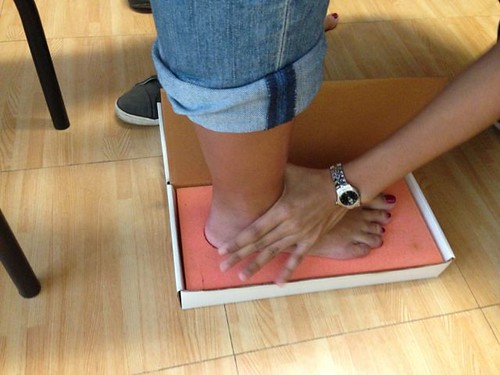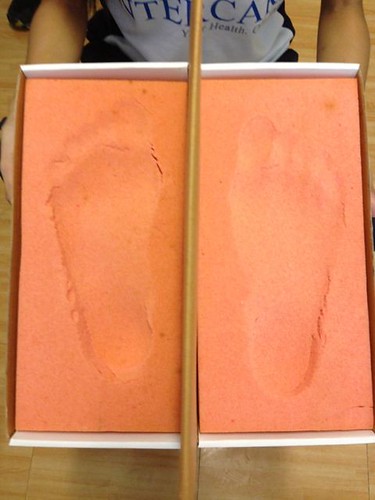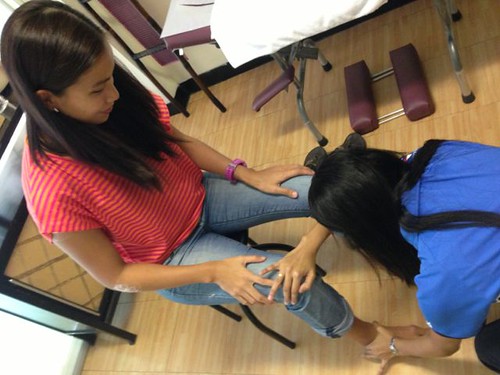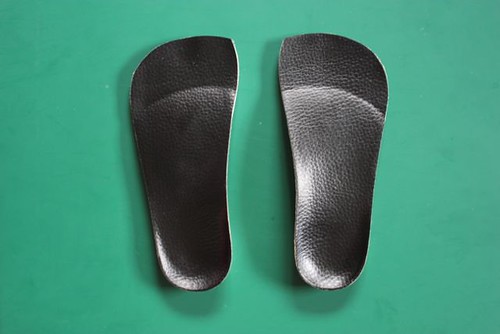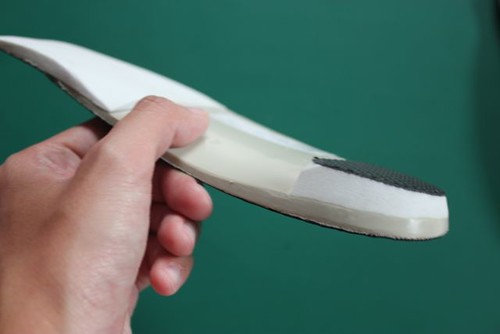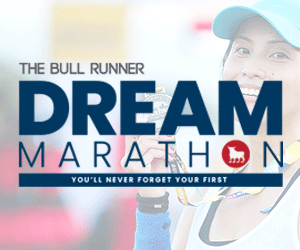Intercare Customized Insoles for Runners
I’m a flatfooted overpronating runner. Since 2006, I’ve been plagued by injuries (name the top 5 common runners’ injuries and I’ve had it) so it’s been a constant challenge to run marathons while keeping injury at bay. While other runners can choose from a variety of shoes, my feet tend to be very picky. I also need to wear orthotics (I used Spenco Orthotic Insoles since 2008) to ensure my arch is well supported.
This year, after a Chiropractic session with Martin Camara at Intercare, he recommended I had customized insoles made at his clinic. I thought it was time to finally have one made.

– with Martin Camara after a Chiro session –
MEDICAL PROCESS FOR PRODUCING CUSTOMIZED INSOLES AT INTERCARE
Last July 4, I dropped by Intercare Alabang to have my feet measured for the insoles. Here’s the medical process in Martin Camara’s words:
1) First a history of the patients condition is taken and an examination of the foot, ankle, or back ensues.
2) A Weight Bearing Foam Impression is made of the patients foot in Sub-Talar Neutral
3) Measurements are taken of the foot, ankle, knees and hip to determine if corrective postings are necessary
4) Orders are sent out to a lab in Hong Kong made by a Canadian Sports doctor who comes with over 20 Years of experience in manufacturing orthotics
5) The Lab will re-create the patients foot in the lab.
6) The material is heated to make it pliable – then placed over the mold of the patients foot. Both are placed inside a vacuum which makes the pliable orthotic conform tightly around the foot.
7) Corrections and postings are added afterwards.
8) They are shipped back to us for fitting on the patient.
I received the finished product within 3 weeks after I had been measured. Here’s how they look:
TBR REVIEW: INTERCARE CUSTOMIZED INSOLES
I received the insoles a week before Ironman 70.3 Cebu. I thought it best NOT to use them in an A-race as I hadn’t had the time to break them in. So, after Cebu and until now, I’ve been using them regularly for runs from 10k to 21k with my Kswiss Kwicky Blade Light, a neutral shoe. For shoes with more stability, such as my Asics Gel Kayano, I don’t use the customized insoles.
PROS:
- Made for your foot. The product is customized for your foot and your needs. If your injuries are severe and chronic and insoles off the shelves aren’t working for you, then insoles customized for your feet is definitely the best choice.
- Provides more stability and support. I didn’t exaggerate when I emailed Martin to tell him: “They work!” They provide stability for my ankles which had been injured last April. I feel the strong support for my arch. My runs have been significantly more comfortable since I started wearing them.
- Lightweight. I had customized insoles done by another supplier way back in 2008 which were as heavy as wood. These insoles are considerably lighter.
- Durable. I haven’t had mine for more than 2 months, but I’ve been told that this pair is durable. By the way it’s made I can already tell that this will last longer than my Spenco Orthotics which I need to replace by 8 months to 1 year.
- Allows for versatility in choice of shoes. For most overpronating or flat footed runners like me, our choice of shoes are limited to the bulky motion control or stability shoes. We couldn’t even try many of the lightweight, fast, and not to mention attractive neutral or minimalist running shoes in the market now. These orthotics may give you the chance to wear neutral or lightweight shoes in safety. (Disclaimer: Just make sure that you test the product out first. Gradually increase mileage in these shoes. Should you feel pain or injury, go back to motion control or stability.)
CONS
- 3/4 length. I’m not a big fan of 3/4 length orthotics for two reasons: They are prone to slipping during the run and they may cause blisters. While these don’t slip at all, I did have huge blisters on my midfoot the first time I wore them. It may be part of the breaking in process as now I don’t get blisters in that area anymore.
- Pricey. A pair costs P8,800. They cost almost as much or more than some running shoes in the market. But given that they will prevent injury (and subsequent fees from the injury) and they will last for years, then it’s worth the investment.
In summary, I highly recommend Intercare’s Customized Insoles for runners who have severe or chronic injuries. It provides support, stability, and peace of mind to the runner who constantly has to deal with or worry about pain and injuries.
Below is an interview I had with Martin Camara to help you decide if Intercare’s Customized Insoles are for you and some tips on how to use them properly should you get a pair:
TBR: How can a customized insole benefit a runner?
The orthotics basically can now take any commercially produced cycling or running shoe – and turn it into a fully customized shoe for that runner or athlete.
1) INJURY PREVENTION – I’m sure we have all seen the statistics when it comes to running and injuries. Some studies quote as high as a 70-80% incidence rate. Most pain or injury is simply a symptom of an underlying problem. So if you experience foot pain, knee pain, hip pain or lower back pain which is associated with your running – a logical assumption would be that there is something wrong with your “alignment” which is putting more pressure on one part of your body versus the other. A good, medical grade orthotic will be able to correct your alignment from the ground up. By correcting the alignment of your foot – you are then balancing out the repetitive stresses that build up over time with running so that there is more even wear and tear on your joints and muscles thereby preventing injuries.
2) INCREASE EFFICIENCY – The orthotic helps place your feet in “Sub-Talar Neutral.” It therefore corrects pronation or supination problems which are all too common nowadays. In this position – the muscles and joints of the body are in the optimum position to perform better over a longer period of time. For example, the achilles tendon (which is the tendon of the calf muscles) pulls from a more efficient angle in Sub-Talar neurtral. This minimizes the pressure on calf, hamstrings and glutes – making the muscle perform better over time and distance.
3) INJURY TREATMENT – Most pain wether in the foot (Plantar Fascitis), Knee ( Patellar Tendinitis), Hip (Ilio-tibial Band), and Lower Back (Sacro-iliac joint dysfunction) are a result of inflammation and irritation. Chiropractic, Physical Therapy or Orthopedics Therapy helps relieve the pain and inflammation however if the underlying problem which brought it on in the first place is not addressed – the condition will quickly return after the runner returns to activity. Orthotics help support the treatment so they don’t continue to re-injure themselves.
TBR: How does a runner know that he/she needs customized insoles? What are the symptoms that he/she should get himself checked?
Pain is a definite sign that they will be needing Orthotics. Recurrent trips to the Physical Therapist, Chiropractor or Orthopedist for problems affecting lets say one side of the body more than the other is also an indication of imbalances which would require corrective insoles. Heel pain, Shin Splints, Iliotibial Band Syndrome, Lower Back Pain are all common conditions that may require orthotics.
If there is no pain present – You would look at the wear patterns of your running shoe. If you consistently wear out one shoe faster than the other – or on one side faster than the other – you may need an orthotic. For example – a pronator will wear out the outside portion of the back of the shoe and the inner portion of the front of the shoe faster. If your running shoe shows those patterns – you may need one.
Another sign is excessive bunion formation on one side versus the other (As a side note – the first time i examined your back I knew you needed them just looking at your big toe bunion formation)
Also if you feel that there is a discrepancy in your leg length – or you come down harder on one side – Orthotics can balance them out.
The analogy would be like the tires on your car – when misaligned you wear them out unevenly over time. When your body is out of balance – you wear out one side faster than the other. Orthotics can help balance you out.
TBR: For the Intercare customized insoles, where are these made? How different are these from other customized and off the shelves insoles in the market?
These orthotics are very different from what is available off the shelf or even made to order orthotics currently available in the Philippines. Most of what is available simply match your shoe size with the size of the orthotic and make the faulty assumption that everyone’s foot is the same. The other type of orthotic I see is a simple arch support with cushioning. Cushioning without correction just softens the landing but does nothing to correct the alignment.
These orthotics correct all components of the foot: Most semi-customized only have a mid foot or arch correction. These orthotics have both mid foot (Arch), Hind foot, and Forefoot corrections. Posting is added to correct leg length discrepancies or pronation or supination problems.
TBR: Can you give us tips on the proper use of customized insoles?
I would recommend you use them with all your shoes.
There are full supports that I would recommend you use for your running and or cycling shoe. I recommend a shoe without excessive correction or cushioning. I personally like a shoe with some padding then I add the orthotic to completely customize that shoe for me. Too much cushioning will lead to the runner losing connection with the ground.
They also have a version for dress shoes – The corrections do not have as much posting – but you can fit them into a dress shoe or even a minimalist running shoe. As I mentioned – for Trail running, I prefer to feel the ground so I use a smaller orthotic.
They also have a hook version for ladies heels.
I would recommend you use them for 3-5 hours day and slowly increase your utilization over a 3 week period until you are using them all of the time.
For running, break them in with 3-5km runs and after 3 short runs – you can start building up longer runs adding 3 km per run.
It is common to go thru an adjustment period. This is because you will be using your muscles differently. This is a Good Thing or a Good Pain. Like muscle soreness after a good workout.

